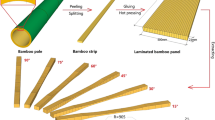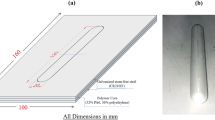Abstract
The mechanical properties of laminated strand lumber are dependent on the orientation of strands and on the variability of strand alignment in the production process. A model is proposed to predict the in-plane properties and their statistical distributions to allow manufacturers to set target reliability levels for their products. The model is based on the theory of mechanics of composites and assumes homogeneity in each panel layer to allow for multiple-layer panels to be simulated. To verify the model, five types of panels are fabricated using aspen strands with the following stacking sequences: (a) fully-oriented (0° throughout); (b) fully-random (R throughout); (c) random core/oriented surfaces (0°/R/R/0°); (d) random surfaces/oriented core (R/0°/0°/R); and (e) eight oriented layers (0°/+45°/−45°/0°/0°/−45°/+45°/0°). In-plane elastic moduli and ultimate strengths (in tension, compression, and shear) are determined for each panel type. Model predictions match well with experimental results. Properties are shown to be dependent on the degree of strand alignment in each panel type. Using the first-order reliability method, statistical distributions on the properties were predicted and found to compare well with experimental results. A method is proposed for dealing with misalignment of strands based on the von Mises distribution of strand angles to assist manufacturers with production process optimization.










Similar content being viewed by others
References
American Society for Testing and Materials (ASTM) (1991a) ASTM D103. Standard test methods of evaluating the properties of wood-base fiber and particle panel materials. West Conshohocken, USA
American Society for Testing and Materials (ASTM) (1991b) ASTM D143. Standard methods of testing small clear specimens of timber. West Conshohocken, USA
Bendtsen BA, Porter S (1978) Comparison of results from standard 2-inch with 1–1/2-inch shear block tests. For Prod J 28:54–56
Bradtmueller JP, Hunt MO, Fridley KJ, McCabe GP (1997) Mechanical properties of OSB via the five-point bending test. For Prod J 47:70–77
Cowin SC (1979) On the strength anisotropy of bone and wood. J Appl Mech ASME Trans 46:832–837
Foschi RO, Barrett JD (1976) Longitudinal shear strength of Douglas-fir. Can J Civ Eng 3:198–208
Foschi RO, Folz B, Yao F, Li H (1997) RELAN: Reliability analysis user's manual. Department of Civil Engineering, Univ of British Columbia, Vancouver, Canada
Hindman D (1999) Elastic constants of selected engineered wood products. Thesis, Pennsylvania State Univ, State College, USA
Hoover WL, Hunt MO, Lattanzi RC, Bateman JH, Youngquist JA (1992) Modelling mechanical properties of single-layer, aligned, mixed-hardwood strand panels. For Prod J 42:12–18
Hunt MO, Hoover WL, Fergus DA (1985) Thick aspen structural flakeboard. For Prod J 35:33–39
Hunt MO, Suddarth SK (1974) Prediction of elastic constants of particleboard. For Prod J 24:52–57
Kaw AK (1997) Mechanics of composite materials. CRC, New York
Liu JY (1984) Evaluation of the tensor polynomial strength theory for wood. J Comp Mat 18:216–226
McNatt JD, Bach L, Wellwood RW (1992) Contribution of flake alignment to performance of strandboard. Forest Prod J 42:45–50
Moses DM, Prion HGL (1999) The influence of strand alignment on the mechanical properties of aspen laminated strand lumber. Internal report, Dept Civil Engineering, Univ of British Columbia, Vancouver, Canada
Shaler SM (1991) Comparing two measures of flake alignment. Wood Sci Technol 26:53–61
Tsai SW, Wu EM (1971) A general theory of strength for anisotropic materials. J Comp Mater 5:58–80
Acknowledgements
Financial support for this project was provided by the BC Science Council, Trus Joist MacMillan and Forest Renewal BC. The authors thank the technical staff in the Departments of Civil Engineering and Wood Science at the University of British Columbia, Bob Myronuk and research assistants Vincent Gan and Patrick Wong.
Author information
Authors and Affiliations
Corresponding author
Rights and permissions
About this article
Cite this article
Moses, D.M., Prion, H.G.L., Li, H. et al. Composite behavior of laminated strand lumber. Wood Sci Technol 37, 59–77 (2003). https://doi.org/10.1007/s00226-003-0169-5
Received:
Published:
Issue Date:
DOI: https://doi.org/10.1007/s00226-003-0169-5




